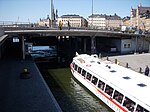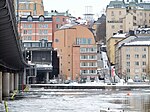Stockholm City Museum

The Stockholm City Museum (Swedish: Stadsmuseet i Stockholm) is a museum documenting, preserving and exhibiting the history of Stockholm. The museum is housed in Södra Stadshuset at Slussen on Södermalm. The building was completed in 1685. In the 1930s the museum moved in and opened to the public in 1942. The museum is the largest municipal museum in Sweden, and houses collections which include 300,000 items of historical interest; 20,000 works of art and 3 million photographs. The City Museum closed for renovation January 12, 2015 and reopened on April 27, 2019.The museum is governed by the Cultural Affairs and Sports Division of the City of Stockholm. The city museum, the Museum of Medieval Stockholm and Stockholmia Förlag (which publishes books on Stockholm and Stockholm's history) operate as one department within the division. All political decisions are made by the specialist committee for Cultural Affairs.One of the museum's units – Cultural Heritage Department – "Kulturmiljöenheten" – is the City of Stockholm's cultural historical authority in relation to city planning proposals, building conversion, demolitions and other changes to the city's visual appearance.
Excerpt from the Wikipedia article Stockholm City Museum (License: CC BY-SA 3.0, Authors, Images).Stockholm City Museum
Götgatan, Stockholm Södermalm (Södermalms stadsdelsområde)
Geographical coordinates (GPS) Address Nearby Places Show on map
Geographical coordinates (GPS)
| Latitude | Longitude |
|---|---|
| N 59.319722222222 ° | E 18.070555555556 ° |
Address
Götgatan
Götgatan
118 46 Stockholm, Södermalm (Södermalms stadsdelsområde)
Sweden
Open on Google Maps








